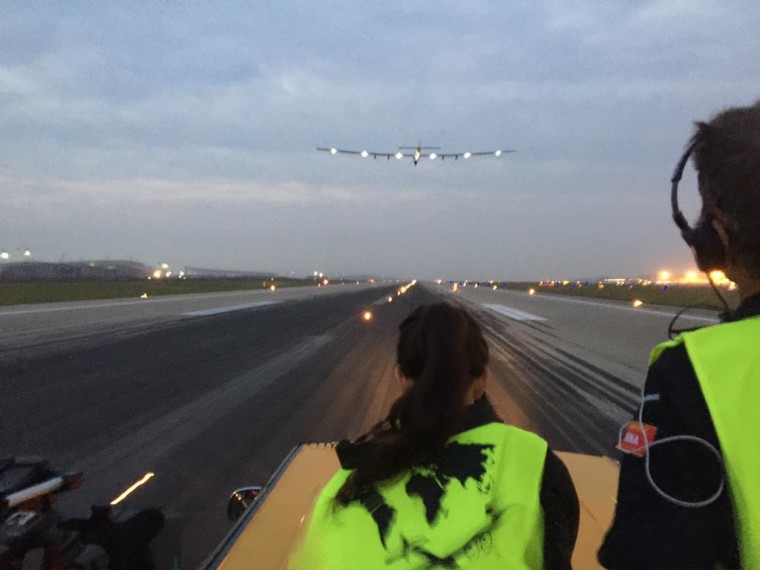After a three-week-long delay due to weather, the Solar Impulse 2 airplane made a dawn-to-midnight flight to the Chinese city of Nanjing on Tuesday — with a perilous Pacific crossing next on the itinerary.
"Finally in the air again!" pilot Bertrand Piccard, co-founder and chairman of the Swiss-led project, said as the solar-powered craft rose from the runway at Chongqing Jiangbei International Airport. The 739-mile (1,190-kilometer) overland flight to Nanjing took about 17 and a half hours.
Commercial air traffic was put into a holding pattern to make way for the alien-looking plane.
Solar Impulse 2's unprecedented globe-girdling trek follows up on an earlier prototype's trip across America in 2013, and is meant to demonstrate the power of clean technologies.
The plane gets all its energy from more than 17,000 solar cells installed on its fuselage, wings and tail — and can fly through the night, thanks to the power stored in more than 1,300 pounds (633 kilograms) of batteries. Its wings are as wide as those of a Boeing 747, but it weighs only about as much as a family car (2.6 tons). The drawback to all that efficiency is that the plane flies as fast as the family car, not the 747.
Also, the plane isn't meant to fly in stormy weather. Solar Impulse's team had to bide their time in Chongqing, waiting for weather forecasters to give the go-ahead. "Today’s flight was like a miracle, because the weather was bad yesterday and will be bad tomorrow," Piccard tweeted from Nanjing.
Piccard's partner in the $150 million Solar Impulse effort, Andre Borschberg, was originally scheduled to take the solo piloting duties for the Chongqing-to-Nanjing flight — but in a tweet, Piccard said Borschberg had to head back to Switzerland "to make sure he is fully operational for our big challenge: the Pacific."

Borschberg was said to be suffering from shingles, but was well enough to tweet his congratulations to Piccard. "I could not be happier," he wrote. Solar Impulse's team said Borschberg will be in shape to take the flight across the Pacific from Nanjing to Hawaii, probably sometime in the next 10 to 20 days.
The flight looms as the most grueling of the odyssey's 12 legs. Borschberg will be confined to the single-seat cockpit for up to five days and five nights straight.
Solar Impulse 2 began the journey on March 8 in Abu Dhabi, and it's visited Oman, India and Myanmar as well as China. Piccard is due to take the controls again for the flight from Hawaii to Phoenix. The stop after that would be made at a spot to be determined in the U.S. Midwest, and then there'd be a trip to New York. The Atlantic crossing would target southern Europe or northern Africa, with the final leg ending in Abu Dhabi.
Closing the 22,000-mile (35,000-kilometer) circuit would make Solar Impulse 2 the first solar-powered airplane to fly around the world.
IN-DEPTH
- Solar Impulse Pilots Psyched for Takeoff
- World's First 'Solar Battery' Stores Energy
- Solar-Powered Drone Could Stay Aloft for 5 Years